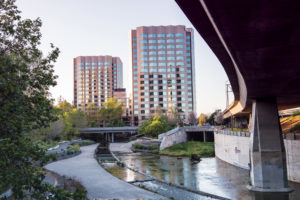arly this summer, I watched a group of ecstatic elementary school students fishing for turtles, frogs and crayfish in the Guadalupe River, just under the Coleman Bridge in downtown San Jose.
The kids grasped their nets tightly, smiles on their faces as they stared into the water for signs of life. The water was only about puddle-deep, nothing like what they might call a river elsewhere in the world, but it was there, a functioning wet ecosystem.
A few weeks ago, I went back to find that the section of the river where earlier the children released their crayfish is now nothing but rocks and dirt. The section of the river located directly under the bridge and protected by shade lays still. Macroinvertebrates hop on the surface of the pools to survive. Riverside vegetation has dried out, and the various animals that live near or in the river have died off. For the last few months, the Guadalupe River, the major river of the 10th largest city in the United States, has been essentially out of water. “I’ve never seen it like this, where many pools of water have evaporated,” says Cindy Moreno, an education coordinator at the Guadalupe River Park Conservancy.
The previous low was 1988, says Richard Tejeda, an education assistant at the Park Conservancy. “I will lift up a rock and it is just wet and there will be thousands of macro invertebrates trying to survive in this one little spot and that dries out and they die,” Tejeda says. “If the drought continues for multiple years then species could be extirpated.”
he lack of water affects a variety of native species, most obviously, perhaps, fish, like the steelhead trout and salmon that are supposed to make their way into the Guadalupe River to spawn — an impossible task without water, obviously.
But even if the water returns this winter, the dry run this summer will leave its mark. No water leads to no algae, and macroinvertebrates such as dragonflies and nymphs — which the juvenile fish eat — start to die. Salmon were due up the river now, as well as Pacific lamprey, which were just waiting for the water to rise.
Steelhead trout that were due to migrate last November through April were not seen or heard of, Tejeda says. They likely won’t be seen this year, either. Natural springs mean the riverbed isn’t completely dry – but at the moment, those springs are just feeding a series of unconnected puddles. “These springs can be found throughout the watershed,” Tejeda says. “There is one near our office and one near the airport for example.”
The river relies on rainwater, of course, but also on controlled water releases from Santa Clara’s reservoirs. With the severity of the drought, those reservoirs have had to completely stop feeding the river. “There is nothing we can do to get the water flowing,” says Marty Grimes, the program administrator at the Santa Clara Valley Water District. “Certainly when rains come it will begin to flow again. We hope that this will happen this winter.”
f there’s an upside, it’s that invasive species that have bedeviled many river restoration efforts are less capable of coping with a prolonged drought. “Frogs and turtles burrow, and our native fish species can’t live here anyway,” Tejeda says. “Although our native species have adapted to the lower levels of dissolved oxygen, they definitely are not immune to the conditions of the drought.” Tejeda says the silver lining to the drought is that invasive species populations along the Guadalupe River will shrink giving federally threatened species such chinook salmon and steelhead rainbow trout an opportunity to repopulate the river.
Andrew Hughan, an information officer with the California Department of Fish and Wildlife, says nonnative bass, bluegill, and Asian carp all live in the river near the Coleman Bridge. Most were brought to the area by fisherman from the east coast, and while they out-compete salmonids – salmon and steelhead — in warm conditions because their metabolisms are adapted to warm, slow moving, or ponded water — they don’t have an oceanic refuge when there’s no water at all.
Moreno says the dry river is also still a powerful tool for teaching about the environment and the drought. Wet or dry, it’s a reminder that natural cycles of rain and dry resonate in even the most urban places. “I think there is a lot of misconception, because we are in the heart of downtown San Jose and because of how urban this park is, that there isn’t a lot of wildlife,” Moreno says. “I’ve even been surprised myself.”
Elementary schools come to the river every year, and for the last three years those children have seen firsthand the way drought affects nature in their hometown. “It is really powerful to see how knowledgeable the younger generations are becoming about the drought and conservation and sustainability issues,” Moreno says. “It’s becoming very relevant for them to be knowledgeable about how to prevent those environmental problems that are going on in our society.”
Tejeda, also a student at San Jose State University with a minor in Sustainable Water Resources strongly believes that the answer to our inner city drought conditions lies in building our recycled water infrastructure.
“I can’t believe we use drinking water to flush our toilets and water our landscapes. This is not 21st-century thinking. If we used recycled water for agriculture, industry, and domestic use we would have a surplus of water for our endangered species and aquatic ecosystems”.
Even though there has been some rainfall earlier in October, Tejeda says it won’t help much because the first rains will bring nothing but street runoff into the river. It will take a few rains and rainfall promised by the upcoming El Nino due in early fall before anyone can see any water in the river because the aquifer is so low.


